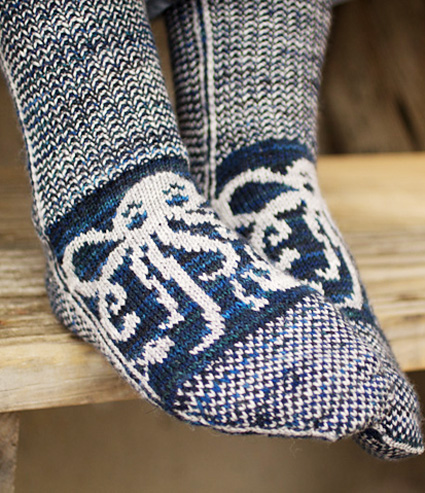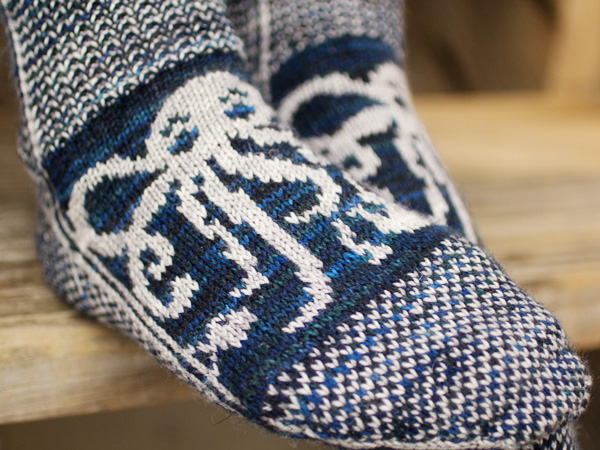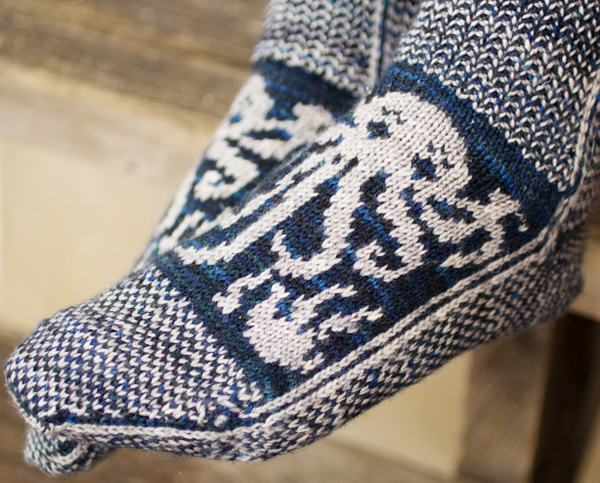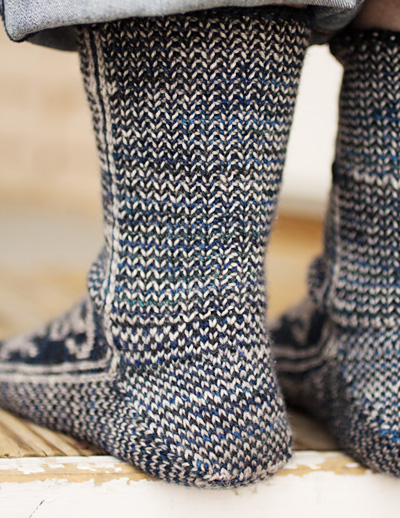

|
|
|

Octopodes are a pair socks with stranded colorwork on the foot, and helix knitting to stripe the ankle. All throughout, a pair of stripes shoot up the sides of the socks from toe to top, creating a strong visual line. I've developed a fondness for cephalopods over the last 10 years. It started in college when one of my biology friends insisted that cuttlefish really were cute, and then extended as I learned just how smart -- in a completely non-human way -- creatures like octopi, squid and cuttlefish are. I wanted to share my geeky love for them. Plus, I love how many different forms of the plural octopus there are. The Oxford English Dictionary lists octopuses, octopi and octopodes as all correct forms. Although, technically octopi is hypercorrect, coming from the mistaken notion that the ūs in octopūs is a Latin second declension ending. Being perverse, I prefer the rarer form of octopodes, which is the ancient Greek plural, oktō-pous being from the Greek, meaning eight-foot. When planning these socks I had some specific requirements: stranded, for warmth, with an afterthought heel [as I always wear my heels out, and afterthought heels are easier to replace since stranded knitting is a pain to darn in pattern]. However, I knew I wanted to carry the two colors of yarn into the ankle, but at the same time I didn't want the ankle in stranded knitting, as it would be too difficult to fit my heels into the socks. Since I have a fondness for helix striping combined with slip stitches, the ankle is as you see. |
||
Tweet
 |
||
|
SIZE |
|
|
FINISHED MEASUREMENTS A note on sizing: these stranded colorwork socks are not very stretchy. We recommend they be worn with zero ease -- that is, you should choose to make the size that most closely matches your foot circumference. If the sock is too short or too long for you lengthwise but fits your circumference, you can make it shorter or longer by knitting less or more rows in the foot before the chart. A note on the heel: to accommodate enough room to slide the sock on, extra room has been added to the afterthought heel to increase the heel diagonal. If your heel diagonal is typically shallow, you might not want to work as many rows in the heel, or only work one repeat of the beginning heel decreases before going onto the 2nd heel decrease chart. |
|
MATERIALS Notions |
|
GAUGE |
| 36 sts/36.5 rounds = 4 inches in stranded colourwork 38 sts/44 rounds = 4 inches in helix knitting |
|
PATTERN NOTES |
|
The Turkish Cast on can be found here Information on Helix Knitting can be found here and here. Information on Color Stranding and Wrapping Floats can be found here. Jeny's Surprisingly Stretchy Bind Off can be found here. Information on Grafting can be found here. |
The charts for this pattern are very large and fit on a letter-sized page. Click here and print the resulting page. |
|
DIRECTIONS 
With MC, using the Turkish Method CO 15[17, 19, 21, 23] sts onto each of two needles -- 30[34, 38, 42, 46] sts total. Distribute sts across your needles as you prefer and join for working in the round. Attach CC. Rnd 1: [Work row 1 of Toe Chart, working 2-stitch repeat 5[6, 7, 8, 9] times] twice. First half of round forms instep; second half of round forms sole. Next round, shift start of round for patterning setup, sizes XS[S, M] only: Work even in pattern as set until 3[2,1] sts rem. This is the new start of round. Foot round: Work Foot Chart around until foot measures 6.5[7, 7.25, 7.5, 8] inches short of full desired foot length; for an average length foot, this might only be a round or two of the chart. Next round: Work Instep chart across first 43 sts of round; pm, work Foot chart across rem 31[35, 39, 43, 47] sts of sole. Work in pattern as set until Row 18[18, 18, 18, 12] of Instep chart is complete. 
Gusset Gusset round: Work across instep in pattern as set; work first 15[17, 19, 21, 22] sts of sole, place marker (for right side of gusset chart), work first row of Gusset Chart, place marker (to mark other side of gusset chart); continue in pattern as set on rest of sole. Continue in pattern as set until 2 full repeats of the gusset chart have been worked. 8 gusset sts added. 82[86, 90, 94, 98] sts total; 39[43, 47, 51, 55] on the sole. Remove Gusset markers. Continue even in pattern as set until Row 41 of the Instep chart is complete. Next rnd: Work Row 42 of Instep chart across Instep as set, and Stop. To setup Afterthought Heel: Turn work so that RS is facing, and return to working yarn at start of sole sts. Work across sole sts in pattern as set to end of round. Next rnd: Work across instep in pattern as set. On sole, k1, k7[8, 9, 10, 11], k3tog] 3 times; k to end of sole in pattern, continuing in two-color pattern. (Decreasing with k3tog will ensure that the pattern remains the same.) 33[37, 41, 45, 49] sts on sole. Continue in pattern as set until all rows of Instep chart have been worked. Take the marker that is used to mark the beginning of sole, and move it back 3 sts. This marker will now mark the beginning of the sole. 40 sts on instep; 36[40, 44, 48, 52] on sole.  The leg pattern is worked in helix knitting, with vertical stripes made using sl sts. Using only CC (leave the MC yarn hanging), k1, sl1, k1, p3tog, [k1, p1] to 7 sts before the sole marker; k1, p3tog, k1, sl1, k1; k1, sl1, k1, p3tog, [k1, p1] until 7 sts left before end of round k1, p3tog, k1, sl1, k1]. 36 sts on instep and 32[36, 40, 44, 48] sts on the sole/back of leg. 68[72, 76, 80, 84] sts around. Leg round 1: Using MC, sl 1, k1, sl 1, [p1, k1] to last 4 sts of instep, p1, sl 1, k1, sl 1; [p1, k1] to last st, p1. Using MC, BO using Jeny's Surprisingly Stretchy BO. Weave in MC and CC ends. Afterthought Heel Next round, start heel chart: Work heel chart, working first 2-st repeat 18[20, 22, 24, 26] times across instep, and then working second 2-st repeat 18[20, 22, 24, 26] times across sole sts. Graft toe closed with Kitchener stitch in MC. If you do not wish the line of single sts to show, pull yarn tight instead of matching to gauge, making the stitching invisible. |
|
FINISHING |
| ABOUT THE DESIGNER |
|
|
|
Pattern & images © 2014 Jennifer Raymond. Contact Jennifer |